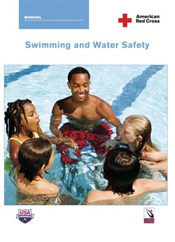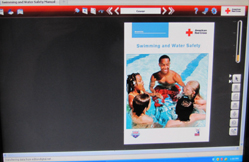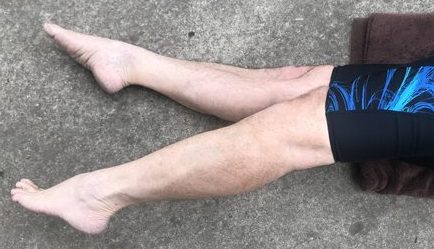Below is a transcript of the Red Cross video of how to swim sidestroke, for my students to enhance their learning.
First, to be able to understand vocabulary about swim strokes, a transcript of the video section on stroke mechanics
“Stroke mechanics are the basic elements of each stroke–body position, breathing and timing, arm stroke and kick. The focus of stroke mechanics is on making the most of propulsive movements while maintaining efficient body position and good body alignment. There are several terms you should understand before we begin studying individual strokes.
Body roll relates to the body position. It is the rotation of the body around the mid line–an imaginary line that runs down the center of a swimmer’s body. This rotation is important in the front and back crawl.
The power phase is the part of a stroke where the arm or leg moves the body in the right direction. The power phase of the arm stroke has three parts–the catch, the mid-pull and the finish.
The pitch refers to the angle of the hands as they move through the water. A good swimmer can feel a change in pitch because the water flow over the hand is different whenever the angle of the hand changes.
The recovery is the part of the stroke where the arms and legs relax and return to their starting position. Some strokes may also have a glide–a part of the stroke when the body keeps moving without any effort from the swimmer.
No two swimmers perform a stroke exactly the same way. You may need to adjust part of a stroke because of individual differences in body type, strength or flexibility. Understanding the basic elements of each stroke is the key to becoming a better, more efficient swimmer.”
Next: the transcript of the Red Cross video of how to swim sidestroke.
“Side stroke is used in recreational swimming and in some survival swimming situations. It’s good for long distance swimming because it requires little energy and breathing is simple. When swimming the side stroke, breathe with each stroke. Inhale during the recovery of your trailing arm and exhale during the power phase of your trailing arm.
To time the stroke, start in the glide position. Begin by sweeping with your leading arm while your trailing arm and legs recover; then propel forward with the kick and stroke with your trailing arm, as your leading arm recovers. Your leading arm should be fully extended when you complete your kick. Glide until your forward momentum slows, then stroke again. Do not glide too long because it takes much more energy to stop and start than it does to keep moving.
Most of the propulsion in the side stroke comes from the kick. The arms provide some propulsion, but are mainly used to stabilize body position. In the glide position, your body is on its side–nearly horizontal in the water. Keep your head, back and legs in a straight line. Your legs are together, toes pointed.
The arm closest to the bottom of the pool is called your leading arm–it is extended forward, in line with the rest of your body a few inches under the surface of the water. Your palm is flat and faces down toward the bottom of the pool. The other arm is called the trailing arm–it is fully extended towards your feet, palm resting on top of your thigh.
Your lower ear rests in the water close to your shoulder. Keep your face high enough so that your mouth and nose are just above the surface of the water for easy breathing. Your head and back should stay aligned throughout the stroke.
The power phase of the leading arm uses a shallow pull. Adjust your pull to a depth that helps you maintain good body position. From the glide position, rotate your leading arm slightly outward in the direction you’re facing. From this catch position, bend your elbow and sweep your hands slightly downward, then back toward your feet until your hand is almost in line with your upper chest. Recover your leading arm by rotating your shoulder, dropping your elbow and turning your palm upward. Pass your hand under your ear until your fingers point in the direction that you’re moving. Continue to thrust your leading arm forward and rotate it until it is fully extended, palm down. Your leading arm is now back in position for the glide.
Your trailing arm begins its stroke with the recovery. Draw your forearm up along your body until your hand is nearly in front of the opposite shoulder. Keep your palm down and pitch slightly forward–this creates lift to make your stroke more efficient and help keep your face above water.
For the power phase, keep your elbow close to your body. Sweep your trailing hand slightly down and backward until your hand is once again in position for the glide. At this point, your arm should be fully extended above your thigh, fingers pointed towards your toes. Your arm should not pass back beyond your thigh. Be sure that the palm of your trailing hand is always pitched towards your feet during the stroke.
Now watch the entire arm stroke as both arms stroke together.
The sidestroke uses the scissors kick. When done well, the scissors kick produces enough forward motion to allow the swimmer a good rest in between strokes. Unlike the flutter kick where the legs are in constant motion, the scissors kick lets the legs rest during the glide.
From the glide position, recover your legs by flexing your hips and knees and drawing your heels upward toward your buttocks. Keep your knees close together. To prepare for the kick, flex your top ankle and point the toes of your bottom foot. Move your legs to their catch position –top leg toward the front of your body, bottom leg toward the back. Your top leg should be almost straight while your bottom leg is bent at the knee. Keep your top legs straight and press backward while your bottom leg pushes forward — like kicking a ball. Push the water with the bottom of your top foot and the top of your bottom foot. As you move your top foot backward, your ankle is flexed at first, then extended with the toes pointed so that the sole of the foot presses with great pressure against the water. Both legs should meet fully extended in the glide position. Don’t let your feet pass each other at the end of the kick. Keep your toes pointed during the glide to reduce drag. Avoid rolling your hips forward and back as you recover and kick. Keep your hips steady and in line with the rest of your body.
Now watch the side stroke in its entirety.”
You can watch the video at the Red Cross swim teacher certification page. This video has more details than you can absorb in one viewing. My students who have seen it during classes multiple quarters in a row say they noticed something new each time.
To find the video go to
https://www.redcrosslearningcenter.org/s/candidate-water-safety
scroll down to the Videos section and click on Swimming and Diving Skills: Sidestroke
(it runs just over six minutes).
If you use Firefox as your browser, you might get an error message: “No video with supported format and MIME type found.”
Google Chrome and Microsoft Edge work as browsers.
![]()
A common mistake with the scissors kick.
When you close your legs together, it is like a pair of scissors closing. This is the power part of the kick. This should put you back to the position to kick again, with legs straight, on top of each other and toes pointed.
When first trying this, many people go past the proper stopping point, which creates drag and slows you down.
(try instead to end with the legs straight and together).
The above photos are from treading water scissors kick at-home practice, where, if you scroll down, you will find drills to learn the scissors kick, that we do in class and at home as a way to learn to tread water.
If you would like to do some reading about swimming strokes, or swimming in general,
try the American Red Cross Swimming and Water Safety Manual.
Its public libraries number is 797.
This is the text for the Red Cross swimming teacher certification Water Safety Instructor.
A description of sidestroke starts on page 137, freestyle on page 116, backstroke on page 121, breaststroke on page 124, butterfly on page 128, and elementary backstroke on page 133.
It might be still downloadable for free. Go to
https://www.redcrosslearningcenter.org/s/candidate-water-safety
scroll down to Participant Materials and click on and open Swimming and Water Safety Manual.


(The American Red Cross Swimming and Water Safety Manual had no index, so I wrote one:
Swimming and Water Safety 2009 index).
The Cooper 12 minute swim test, which we do in my higher level swim classes, is on page 192, where it says “The 12-minute swimming test, devised by Kenneth Cooper, M.D., is an easy, inexpensive way for men and women of all ages to test their aerobic capacity (oxygen consumption) and to chart their fitness program.”
How can I tell if I’m a good swimmer? has more tests
Or should we call that page, how can I tell if I’m a fast swimmer?
See also: common errors in freestyle swimming
see also: Backstroke swim video transcript
Butterfly swim video transcript
Breaststroke swim video transcript
Freestyle swim video transcript




